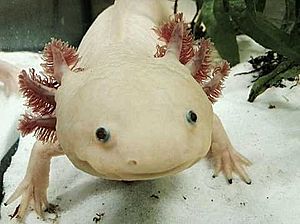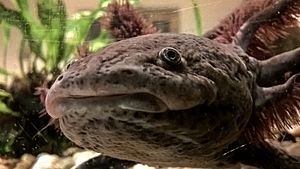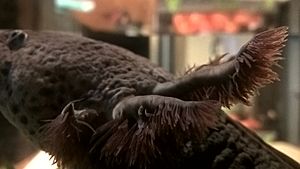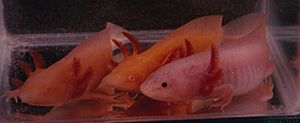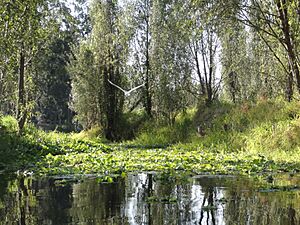Axolotl facts for kids
Quick facts for kids Axolotl |
|
|---|---|
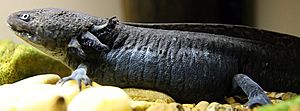 |
|
| Conservation status | |
| Scientific classification | |
| Genus: |
Ambystoma
|
| Species: |
mexicanum
|
 |
|
| Its distribution is marked in red. | |
| Synonyms | |
|
|
The axolotl (from Classical Nahuatl: āxōlōtl), Ambystoma mexicanum, is a salamander closely related to the tiger salamander. Axolotls are unusual among amphibians because they reach adulthood without undergoing metamorphosis. They keep their legs and gills. The species was originally found in several lakes near Mexico City. Spanish settlers drained the lakes, destroying much of the axolotl's natural habitat.
Wild axolotls are listed as critically endangered. Captive axolotls are studied because of their ability to regenerate limbs, gills, and parts of their eyes and brains.
Contents
Description
An axolotl does not go through metamorphosis like most amphibians do. Most amphibians lose their gills, develop lungs, and live on land when they get older. Axolotls keep their gills, which look like delicate feathers, and they live in the water. However, they do develop lungs, which they use when they go above the water's surface.
At age 18–27 months, a mature adult axolotl ranges in length from 15 to 45 cm (6 to 18 in). Their heads are wide, and their eyes are lidless. Their mouth is shaped in a way that makes it look like they are always smiling. Males are wider in the rear, and females are wider in the middle, where they carry their eggs.
Axolotls have four pigmentation genes. They vary in color from pinkish to brownish-green. Pet owners like the white/pink colors most. Axolotls also have some ability to change their color to provide better camouflage.
Habitat
In the wild, axolotls are only found in one lake, Lake Xochimilco, outside Mexico City. The water temperature in Xochimilco rarely rises above 68 °F (20 °C), although it may fall to 43–45 °F (6–7 °C) in the winter, and perhaps lower.
Reproduction
Axolotls can reproduce up to three times a year. The mating ritual looks like a dance. Afterward, the female lays 100-300 eggs. In 10-14 days, the eggs hatch, and the babies are left alone.
Diet and predators
In the wild, axolotls eat almost anything they can catch with their vestigial teeth, including mollusks, worms, fish, and even insects on the water's surface. In captivity, they eat similar things: trout and salmon pellets, frozen or live bloodworms, earthworms, waxworms, and feeder fish.
The axolotl does not have many predators. Storks, herons, carp, and tilapia are the predators that eat axolotls the most.
Conservation Status
The wild population of axolotls is very small, with less than 1000 axolotls left. They are considered critically endangered.
Threats
Axolotls are only native to the Mexican Central Valley. Although the native axolotl population once extended through most of the lakes and wetlands that make up this region, the native habitat is now limited to Lake Xochimilco as a result of the expansion of Mexico City. Lake Xochimilco is not a large body of water, but rather a small series of artificial channels, small lakes, and temporary wetlands.
Lake Xochimilco has poor water quality, caused by the region's aquaculture and agriculture demands. It is also maintained by inputs of only partially treated wastewater. Water quality tests reveal a low nitrogen-phosphorus ratio and a high concentration of chlorophyll a, which are indicative of an oxygen-poor environment that is not well-suited for axolotls. In addition, the intensive use of pesticides from agriculture around Lake Xochimilco causes run off into the lake and a reduction of habitat quality for axolotls. The pesticides used contain chemical compounds that studies show to sharply increase mortality in axolotl embryos and larvae. Of the surviving embryo and larvae, there is also an increase of morphological, behavior, and activity abnormalities.
Another factor that threatens the native axolotl population is the introduction of invasive species such as the Nile tilapia and common carp. These invasive fish species threaten axolotl populations by eating their eggs or young and by out-competing them for natural resources. The presence of these species has also been shown to change the behavior of axolotls, causing them to be less active to avoid predation. This reduction in activity greatly impacts the axolotls foraging and mating opportunities.
There has been little improvement in the conditions of the lake or the population of native axolotls. Many scientists are focusing their conservation efforts on translocation of captive-bred individuals into new habitats or reintroduction into Lake Xochimilco. The Laboratorio de Restauracion Ecologica (LRE) in the Universidad Nacional Autonoma de Mexico (UNAM) has built up a population of more than 100 captive-bred individuals. These axolotls are mostly used for research by the lab but plans of a semi-artificial wetland inside the university have been established and the goal is to establish a viable population of axolotls within it. Studies have shown that captive-bred axolotls that are raised in a semi-natural environment can catch prey, survive in the wild, and have moderate success in escaping predators. These captive-bred individuals can be introduced into unpolluted bodies of water or back into Lake Xochimilco to establish or re-establish a wild population.
Use as a model organism
Scientists are interested in studying axolotls. They are easy to breed, and the embryo is large, which helps scientists see the full development. Axolotls can regenerate body parts and go through metamorphosis differently than other amphibians.
Regeneration
The axolotl does not heal by scarring and can regenerate entire lost appendages in months. Sometimes they can regenerate more important structures, like parts of the central nervous system and tissues of the eye and heart. They have also been able to grow an extra limb when they are repairing a damaged one. Pet owners like axolotls with an extra limb.
Metamorphosis
Axolotls do not have enough thyroid-stimulating hormone to go through a full metamorphosis: they keep their gills and live in the water. Although they use their gills to breathe, sometimes they use their newly developed lungs if they go above the water. One way to help the axolotl go through a full metamorphosis is to give it an injection of iodine, but this can hurt it. They are cute and unique in the way they are created.
Captive care
The axolotl is a popular exotic pet. Pet owners must be responsible in their care. Chlorine, including what is normally in tap water, should not be put in the tank. Salts, such as Holtfreter's solution, are often added to the water to prevent infection. The tank's temperature should be kept at approximately 61 °F (16 °C) to 64 °F (18 °C). A single axolotl typically requires a 40-gallon (150-liter) tank. Axolotls spend the majority of their time at the bottom of the tank.
The material at the bottom of the tank is important. Axolotls sometimes eat their bedding material, and it can become stuck in their intestines and cause them to die. Pet owners should use items that have a diameter of 3 or more cm (or approximately the size of the animal's head) to put at the bottom of the tank.
Cultural significance
The species is named after the Aztec deity Xolotl, who transformed himself into an axolotl. They continue to be an important role in the culture of Mexico and can be seen in cartoons and murals.
In 2020, it was announced that the axolotl would be shown on the new design for Mexico's 50-peso banknote, along with images of maize and chinampas.
Interesting facts about the axolotl
- The axolotl is sometimes called the "Mexican walking fish."
- Legend says the axolotl is the Aztec god of fire and lightning, Xolotl, who disguised himself as a salamander to avoid being sacrificed.
- Axolotls look like babies for their entire lives. They do not go through a full metamorphosis.
- They can reach top swimming speeds of up to 10 mph (15 km/h).
- The axolotl can live for up to 15 years.
- Axolotls have the ability to detect electric fields.
- They usually live alone and only interact with other axolotls to mate.
- Axolotls can accept organ transplants and quickly restore the organs’ functions.
See also
 In Spanish: Ajolote para niños
In Spanish: Ajolote para niños
- Mudpuppies
- Olm
- Texas salamander
- Texas blind salamander
- Lake Patzcuaro salamander
- Barred tiger salamander
- Amphibious fish
- Handfish
- Regenerative biomedicine



